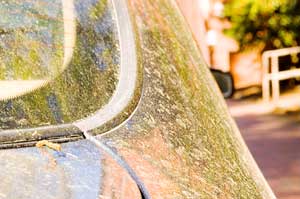It is that time of year. Puddles are outlined in chalky yellow scum and sidewalk cracks are filled with the fine dust. Cars are coated in a dingy yellow-green; pollen even filters its way indoors, powdering desktops and lab benches.
It is mating season for trees. The male gametes, otherwise known as pollen grains, are blowing around en masse in their quest to fertilize female plants, annoying car owners and aggravating allergies.
“You’ve got a car that’s rapidly looking like a shambles, but you’re not supposed to hose it off because of the water restriction,” John Brightwell, a graduate student in entomology, said. “And you don’t want to go out and Swiffer your car. That would look pretty silly.”
Leslie Hester, a graduate student in forestry and environmental resources, is more concerned about the allergy problem. Springtime pollen gives her nasty headaches.
But not all pollen is equally to blame for the mess or the allergies.
Blowing in the wind
“WeÕre seeing pine, oak and hickory pollen right now,” Rich Braham, professor of forestry and environmental resources, said. “People are allergic principally to oak pollen. Pine pollen is just a nuisance factor — it coats the windshield of your car, it gets behind your contact lenses, but the sneezing is mostly due to oak, which is released about the same time.”
Whether pollen can cause an allergic reaction depends on its size, shape and chemical properties — which relies on the mating strategy of the plant.
Few people ever develop allergies to the pollen of flashy, strong-smelling flowers. Their colors and scents attract animal pollinators, and their pollen is so large and heavy that it will not become airborne unless attached to a pollinator such as an insect, hummingbird or bat.
The yellow haze and the allergic reactions come from plants with subtly colored and unscented reproductive structures that rely on wind — not animals — to disperse their pollen.
“Wind-pollinated species are very inefficient compared to insect-pollinated plants,” Steve McKeand, professor and co-director of the University’s tree improvement program, said. “You’re just throwing your pollen up in the air and hoping it doesn’t run into a windshield, Reynolds Coliseum or a sidewalk somewhere. It’s totally up to chance whether a pollen grain hits a female cone.”
That is why wind-pollinated trees make so much pollen. The odds of any given grain actually hitting a female flower or cone of the same species are vanishingly small.
Even if a grain makes it to the right structure, it might not fertilize a seed.
“A female pinecone produces 100 to 150 seeds,” McKeand said. “Three to four pollen grains could have reached each seed, but [fertilization] happens on a first come, first served basis. A difference of 20 seconds could determine which pollen grain fertilizes the seed.”
Still, not all wind-pollinated species are to blame for spring fever, technically known as seasonal allergic rhinitis. This condition affects nine to 16 percent of Americans, according to the Web site of the National Institute for Allergy and Infectious Diseases.
What makes an allergy
“The allergic response depends on properties of the surface of the pollen grain,” J. B. Jett, interim dean of the College of Natural Resources, said. “Is it spiny and irritating, or is it a more forgiving kind of shape?”
Even though pines get a bad name for their contribution to the yellow mess each spring, their pollen falls into the “more forgiving” category. According to Jett, pine pollen’s relatively large size, smooth surface and rounded shape cause foresters to describe it as “a pair of Mickey Mouse ears.” A shape which also makes the pollen hypoallergenic.
According to the NAIAD Web site, the proteins coating pine pollen are less allergenic than those on the surface of many other pollens. That is not to say pine allergies do not exist.
“It’s not quite that clear cut,” Darryl Zeldin of the National Institute of Environmental Health Sciences said. “Plenty of people are allergic to pine pollen.”
But it is the venerated hardwoods like oak and maple, as well as smaller wind-pollinated plants like ragweed and grasses, that are responsible for more sniffles. Their pollen grains have spiny textured surfaces and are coated in proteins likely to cause allergies.
An allergy is a hypersensitive response where the immune system treats otherwise harmless particles as if they were disease-causing organisms.
“You and I know there’s nothing wrong with dog or cat dander or pollen,” Stephanie Schiller, physician’s assistant at the Allergy, Asthma and Sinus Center, said. “But your body can overreact, and that’s what causes an allergy.”
The reaction starts before symptoms ever appear, during a sensitizing exposure to the allergen or foreign protein. When the body first recognizes an allergen it is taken up by immune cells that initiate a chain reaction, culminating in the synthesis of antibodies.
“At this point, lymphocytes are revved up, ready to make antibodies,” Zeldin said. “But the allergy is when you get re-exposed to the same allergen at some later time. When the allergen comes into contact with the antibodies, mast cells are activated and release histamine and other mediators that cause redness, swelling and itching.”
Some people are genetically predisposed to generate antibodies more readily than others, Jason Troiano, staff physician at Student Health Services, said.
But even those who have developed antibodies to certain pollens can minimize discomfort by lowering their exposure.
“The main thing is avoidance,” Schiller said. “Stay indoors on high pollen days, especially in the mornings; keep your dorm or car windows closed; wear sunglasses outdoors and wash your hands often.”
var uslide_show_id = “a6df3b05-f438-4501-8d37-c4b01db9e169”;var slideshowwidth = “230”;var linktext = “”;








